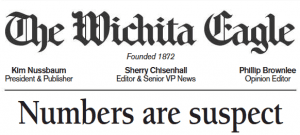A recent Wichita Eagle editorial penned by Rhonda Holman took Governor Sam Brownback to task for a mistake made in reporting Kansas spending numbers. (Eagle editorial: Brownback ’s numbers are suspect.)
Specifically, Holman wrote:
What’s going on here is clear: Brownback is embracing and repeating numbers that help promote his agenda, including what he sees as the need to push back against a court order for more state funding of public schools.
But Kansans need to trust that what they hear from their governor, especially again and again, is rooted in truth, not cherry-picked, spun or flat wrong.
So let’s look at the use of numbers by the Wichita Eagle editorial board. When discussing school spending, the editorialists refer to base state aid per pupil and treat that as though it was the totality of school spending.
Base state aid per pupil is just part of school spending, and most schools spend much more than that. Specifically, base state aid per pupil for the last school year was $3,780. But the state spent an average of $6,983 per pupil that year, which is an additional $3,203 or 84.7 percent more than base state aid. Overall spending from all sources was $12,656 per pupil. Both of the latter numbers are higher than the previous year.
Also, base state aid per pupil has declined in recent years. That’s a convenient fact for school spending boosters. They can use a statistic that contains a grain of truth in order to whip up concern among the uninformed over inadequate school spending. They can cite this as an argument for increasing spending, even though spending has been rising.
(By the way, when citizens in Kansas and across the nation are asked questions about school spending, we learn they are totally uninformed. Even worse, several candidates for the Wichita school board are similarly uninformed. See Wichita school board candidates on spending.)
Further, citing only base state aid reduces “sticker shock.” Most people are surprised to learn that our schools spend $12,656 per student. It’s much easier to tell taxpayers that only $3,780 was spent. But that’s not a complete picture. In fact, using base state aid as a measure of school spending defines “cherry-picked,” a practice of which Holman accuses the governor.
Informed readers are left wondering whether the Eagle editorial board is ignorant of these facts, or does it have an agenda to push — just like they accuse Brownback.
Here’s something else from Holman in the editorial:
Plus, Brownback has said that “29 percent of Kansas fourth-graders can’t read at a basic level.” That’s a misuse of the results of the 2011 National Assessment of Educational Progress survey, in which Kansas actually ranked 10th best in the nation. The better measure is the state assessment, which found 10.1 percent of fourth-graders failed to meet the state standard in reading that year.
The high ranking of Kansas on the NAEP can be explained by the demographic composition of Kansas students compared to other states. As I show in Kansas school test scores, in perspective, Kansas students score better than Texas students on the NAEP. This is a fact congruent with Holman’s citing of Kansas’ high ranking among the states.
But it is also true that Texas white students score better than Kansas white students, Texas black students score better than Kansas black students, and Texas Hispanic students score better than or tie Kansas Hispanic students. The same pattern holds true for other ethnic subgroups. If we examine figures for low-income students, we see a similar pattern.
How can this be? You have to look more closely at the figures than the Wichita Eagle editorial board is willing or able. But if you do this, you will understand more about Kansas schools.
As far as relying on Kansas state assessments to gauge our schools’ performance, we need to be careful. When compared to other states, Kansas has low standards, and these standards have declined.
The U.S. Department of Education’s National Center for Education Statistics (NCES) has analyzed state standards, and we can see that Kansas has standards that are below most states. The table of figures is available at Estimated NAEP scale equivalent scores for state proficiency standards, for reading and mathematics in 2009, by grade and state. An analysis of these tables by the Kansas Policy Institute shows that few states have standards below the Kansas standards.

The editorial board might also wonder why scores on the Kansas assessments — the ones under control of Kansas education officials — are rising, while NAEP scores are not.
A reader sent in this comment, which I believe is apt:
To paraphrase a trusted source:
“[The Eagle’s] numbers matter because they’re being used by [Democrats] and [government employees’ unions] to guide and justify state spending policy decisions, especially in education. The [Eagle] has used [misleading statistics] to drum up public support for plans to [raise] income taxes and to [support] a recent court decision that found the state isn’t meeting its constitutional mandate to provide adequate funding for schools.”
I don’t expect a correction anytime soon.
Wichita Eagle editorial board: When writing that “Kansans need to trust that what they hear from their governor, especially again and again, is rooted in truth, not cherry-picked, spun or flat wrong” please apply this standard to yourself.

Leave a Reply